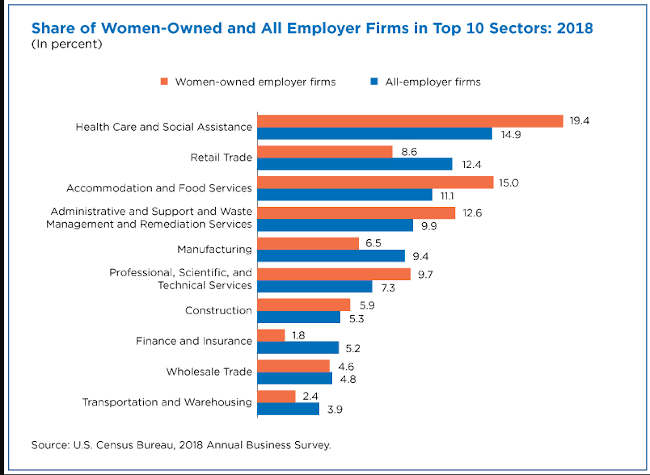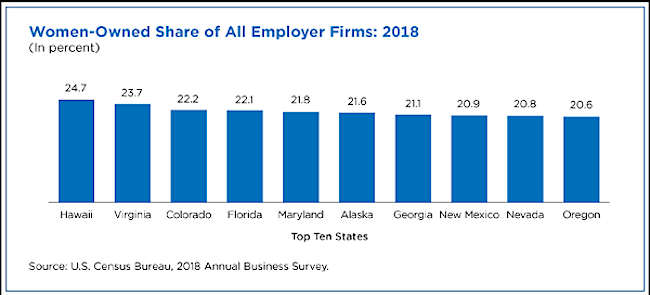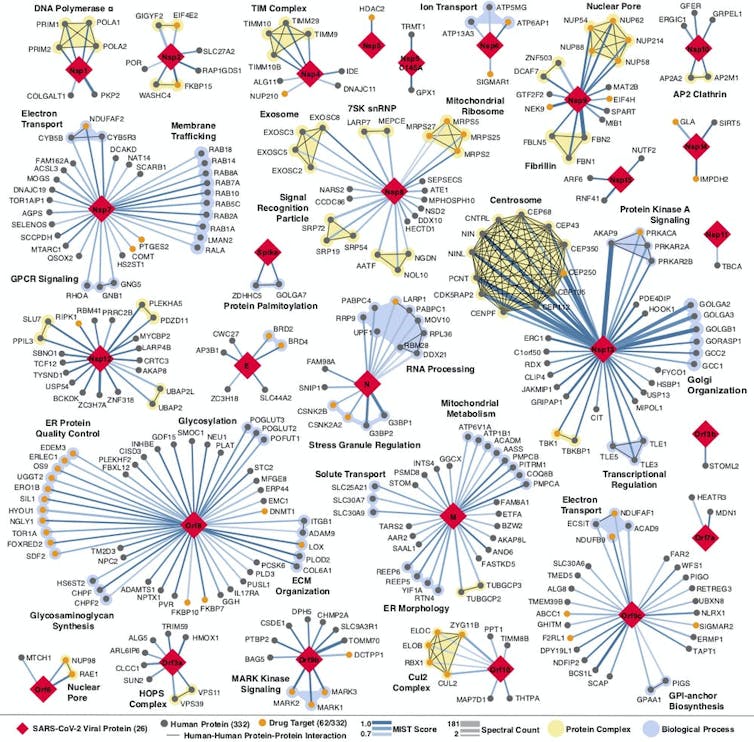- ANDREW W. HAIT
- Posted On
Women business ownership in America on the rise

Women-owned firms made up only 19.9% of all firms that employed people in the United States in 2018 but their numbers are growing.
There were 6,861 more women-owned firms in 2018 than in 2017, up 0.6% to 1.1 million, according to the Census Bureau’s Annual Business Survey, or ABS.
Women-owned employer firms reported nearly $1.8 trillion in sales, shipments, receipts or revenue and employed over 10.1 million workers with an annual payroll of $388.1 billion in 2018.
The ABS provides data on race, ethnicity, sex and veteran status of owners of businesses with one or more paid employees. This information can be invaluable in helping economic development organizations promote growth of minority and women business ownership in their areas.
As the nation recognizes Women’s History Month, this data highlights some of women’s contributions to our economy.
Women business growth by sector
Women-owned firms in the Arts, Entertainment, and Recreation sector rose 10.5%, from 22,219 in 2017 to 24,542 in 2018. The 10 sectors shown in the chart below also saw growth in women-owned businesses.
Characteristics of women business owners
Demographic characteristics of the nation’s women-owned firms are similar to their male-owned firm counterparts.
Most women-owned businesses are run by White women (82.8% of all women-owned firms), non-minority (74.6%), non-Hispanic (92.4%), and non-veteran (98.9%).
Are there more women-owned businesses in some sectors?
Women-owned firms tend to be more concentrated in certain sectors than all firms overall. According to the ABS, 191,230 or approximately 16.8% of the nation’s total 1.1 million women-owned firms in 2018, were classified in the Professional, Scientific, and Technical Services sector, compared to 14.3% for all firms in the sector.
Employees of women-owned firms were also concentrated in certain sectors. Nearly 2.0 million or approximately 19.4% of the 10.1 million employees of women-owned firms worked in the Health Care and Social Assistance sector in 2018, compared to 14.9% of all firm employees.

Sex parity
Average annual earnings of employees of women-owned firms lag behind the national earnings average of the workers of all firms: $38,238 in average annual payroll per employee compared with $54,114.
Women-owned firms in nine of the 20 sectors the ABS covered had average annual payroll per employee statistically lower than the total for all firms in those sectors.
The lack of sex parity was also visible in average annual sales, shipments or revenue.
In 2018, women-owned firms earned an average of $1.6 million in sales, shipments or revenue; male-owned firms earnings were double that at $3.2 million.
What states have the most women-owned businesses?
With more firms than any other state (742,139), it’s not surprising that the nation’s most populous state, California, also had the most women-owned firms in 2018.
California’s 149,927 women-owned firms employed over 1.3 million workers with $57.4 billion in annual payroll in 2018.
In Hawaii, women-owned firms made up 24.7% of all firms in the state. In Virginia, women-owned firms made up 23.7% of all firms, and in Colorado women-owned firms made up 22.2% of all firms in the state.
In terms of employment, women-owned firms in Montana made up 11.0% of all employees in the state.
Women-owned firms in the District of Columbia reported average annual payroll per employee of $57,031, higher than the national average of $38,238 for all women-owned firms in the United States.

What about the self-employed?
In addition to ABS data on women-owned employer businesses, the new Nonemployer Statistics – Demographics (NES-D) program publishes data on women-owned nonemployer firms, typically referred to as self-employed. The 10.6 million self-employed women-owned firms in 2017 reported sales, shipments, or revenue of $286.1 billion.
The NES-D program supplements ABS data and includes similar breakouts by the race, ethnicity and veteran status of the business owner. It also includes data the business itself, including the industry classification, and breakouts by receipts size and legal form of organization. Combining the ABS and NES-D data gives us the total number of women-owned firms in the United States.
Some key statistics from the 2017 NES-D:
– The nearly 1.6 million Hispanic women-owned firms reported sales of $34.7 billion in 2017.
– The nearly 3.7 million minority women-owned firms reported sales of $83.8 billion in 2017.
– The 142,000 veteran women-owned firms reported sales of $3.1 billion in 2017.
Where do we go from here?
As governments and communities strive to encourage business ownership by people who mirror the race and ethnicity of their residents, there is also a push to have business ownership reflect the sex of the workforce.
The Census Bureau’s ABS and NES-D provide key data that federal agencies, for example, can use to promote business ownership by women.
The Small Business Administration, the Department of Commerce’s Minority Business Development Agency, and the National Women’s Business Council also provide key resources to encourage women-owned businesses, along with dozens of federal, state, local and private sector organizations.
ABS data are only possible thanks to the millions of businesses who respond to Census Bureau surveys and programs.
Note: All comparative statements made in the text of this story have undergone statistical testing and are significant at the 90% confidence level. Comparisons shown in the tables and graphics have not been tested for statistical significance and, therefore, should be interpreted with caution. Differences between estimates may be attributed to sampling or nonsampling error rather than to differences in underlying economic conditions. Use caution drawing conclusions from the estimates and comparisons shown. For more information on the survey methodology, including sampling error and nonsampling error, check out the ABS website. All dollar values are expressed in current dollars, i.e., they are not adjusted for price changes.
Andrew W. Hait is a survey statistician/economist at the Census Bureau.













